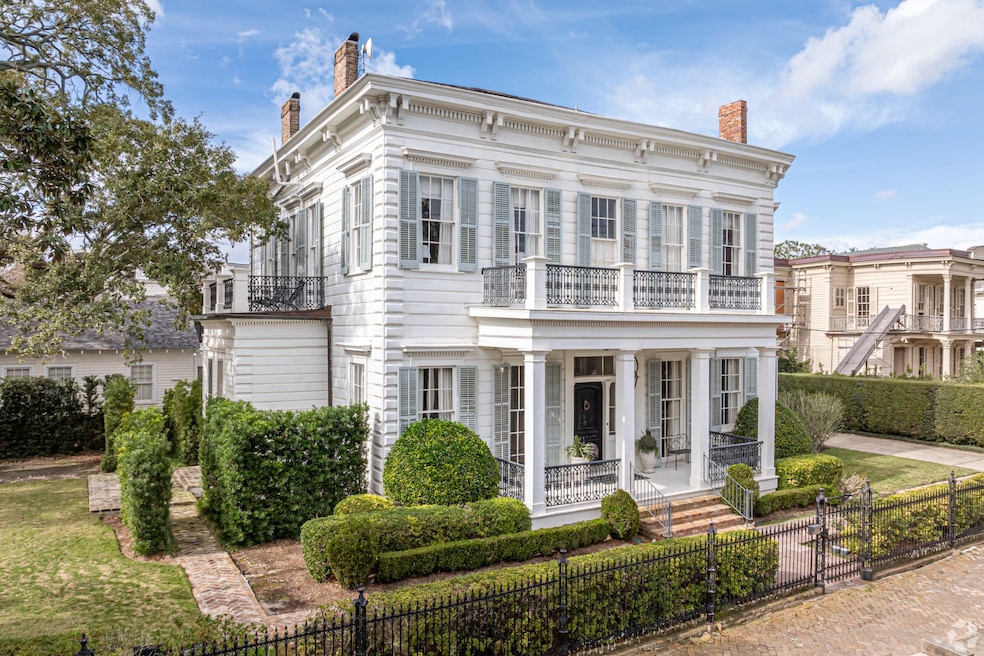It was mid-19th-century America, but Renaissance-era Italian architecture was all the rage.
Captivated by the flourishes of Florentine palaces, Medici villas, and Tuscan farmhouses, builders and homeowners across the United States emulated the structures in their work, popularizing Italianate-style homes in the early 1850s. Although builders across the country put localized spins on the look, many of these homes boasted ornate moldings and decorative iron elements common among Victorian-era residences and made accessible to more homeowners by the industrialization of architectural detailing.
Often, Italianate homes had low roofs. Although similar to the dormer-studded roofs of Second Empire homes, these were not mansard roofs. Instead, they were irregular and generally had projecting eaves resplendent in intricate moldings, typically supported by ornamental, S-shaped brackets.
Sometimes, these brackets supported hipped roofs, explained James Glass — the founder of Historic Preservation and Heritage Consulting in Indianapolis and author of “Architecture in Indianapolis” — and “where you have the outer sides come together in a platform or ridge.”
Italianates also favored quoins, or stone blocks at the building corners, and round-headed windows capped with decorative crowns. Still, these homes were vertically oriented, so their round-topped windows were tall and narrow. It was as if the homes were “made of putty” and pulled upward, causing the attenuation of window and door frames, according to an article from the National Park Service.

Some homes even boasted square cupolas or belvederes on the roof, and portico-covered porches, according to the National Trust for Historic Preservation, but those elements weren’t a given.
“But there’s a lot of variety,” said Glass, also a deputy state historic preservation officer for Indiana. “Italianate, like most styles, can have variations all over the country and regional differences are sometimes notable.”
Those differences often include the materials used. In Indianapolis, Glass’s area of expertise, that means lots of wood Italianates thanks to Indiana’s abundant hardwood forests. The region also had some brick and masonry Italianates, “but they were probably in the minority,” he said. “That was the mark of a higher-costing house.”
“Sometimes the facades are symmetrical, and sometimes they’re asymmetrical,” he said. “There’s also some variety in how you mass the different parts of the house — some of them are just rectangles, others have a projecting central pavilion at the facade.”

Pattern books spurred Italianate popularity
Nailing down what attracted people to Italianate style buildings amid their heyday is tricky — but that’s true of many trends.
“It’s the nature of fashion or fads, you might say, the same thing in art or home furnishings,” Glass said. “There are periods of fashion.”
“Who knows exactly what kicks off a fashion,” Glass said, but this particular fad came on the heels of classically oriented Greek and Roman revival architecture. Italianate design was a bit more free-flowing, a bit more open to improvisation, and, Glass pointed out, it came with pattern books “that were bought, circulated and used by builders and architects as the source of their design.”
Designers could create their own recipe, pulling details from one house pattern and combining them with the layout of another. But design professionals weren’t the only ones looking at patterns: Homeowner agency was a key aspect of Italianate popularity. Thanks to a — you guessed it — rapidly industrializing printing process, architectural pattern books proliferated across the country, introducing run-of-the-mill homeowners to new building styles.
“These books, once considered too costly to reproduce, were now less expensive so families and builders alike could use them as reference manuals in designing their own buildings,” according to the National Park Service.

Costly updates can come with a connection to the past
Although their popularity began waning in the 1880s, Italianate homes endure. Today, those 1850s-era homes are nearing 175 years old, meaning they face their owners and homebuyers with the usual old-home problems — outmoded interior layouts, mechanical systems that need updating and general repairs.
And, if they’ve suffered from improper care and deferred maintenance, those romantic Italianate details, the “stylistic elements like brackets, cornices, and window hoods … can deteriorate and need to be repaired or replaced,” Glass said. “And then the question is: Do you have people who are skilled in preservation trades, if you want to do something that’s really authentic, in your area?”
Faced with a waning pipeline, he noted, those specialists are becoming increasingly harder to find and can present homeowners with additional costs.
Glass has seen interest in the homes cycle in and out of focus. When he began his career as an architectural preservationist in the 1970s, there was a booming interest in these Victorian-era homes, he said.

“More recently, many younger buyers are looking for midcentury modern … and are not interested in styles before 1930, which had more historical elements.”
Even so, he noted, some homebuyers are lured in by older neighborhoods spotted with Italianate homes. “It’s not cookie-cutter,” Glass said. As these neighborhoods are built and expanded over time, “you have a lot of variety of style and materials. I think that appeals to people, the connection with the past.”
